Mainstream scientific theories on life origins, the Vendian World and a look at some of the first life forms that existed on Earth.
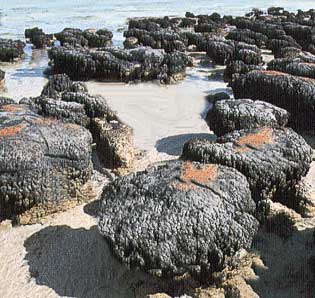
Stromatolites, are some of the earliest forms of life discovered on Earth, some dating 3.4 billion years old. Cyanobacteria are microbes which act photosynthetically, collecting energy from light. Trapping sediment, cyanobacteria cement together to form mounds like those featured in the image above. One fossil sometimes found in stromatolite mounds, that are of interest to researchers are tiny Cloudina fossils, an early organism which built itself a mineralized shell.
Paraphrased and image based on Kingfisher Illustrated Dinosaur Encyclopedia
David Burnie, 2001
ABIOGENESIS AND THE FIRST LIFE
Science searches for empirical solutions to empirical problems. One of those problems is to answer How life began. One possible explanation, is that early in Earth's history, a series of random chemical reactions occurred between carbon substances. Some of the chemical reactions may have formed microscopic bubbles, coated with oily membranes shielding inner-fluid from the outside water. Some may have formed a substance that could copy itself, by attracting simpler chemicals. If these two had came together, and began using energy, it may have produced the first self-copying single "living" cells.
One thing is certain. The first living organisms on earth were bacteria. These first microbes derived their energy from dissolved chemicals. As bacteria multiply, the chemical resources used for food, are diminished which sets up a struggle for survival. This challenge is a factor in what makes living organisms evolve. Three billion years ago, bacteria met the challenges and developed Photosynthesis, the ability to collect energy from light.
A ball of carbon, found on Akilia island off Greenland holds the record as possibly the oldest evidence of life on Earth. The carbon ball, yielding an excess of carbon-12, the fingerprint of life, magnified 6900 times, is cradled in a cavity of a rock that dates 3.86 billion years old. This specimen has lost all of its meaningful anatomical characteristics, though believed it must be similar to all life it preceded.
Source: Paraphrased and image based on Exploring The Solar System, National Geographic, J. Kelly Beatty
Discovered in Vendian Strata of China from about 570 million years ago, this fossil embryo is of an unknown organism, and measures 0.1 millimeters across, less than 1/20 of an inch.
Source: Image from Early Animal Life and paraphrased from Atlas of Prehistoric World, Discovery Books
Life propagates and thrives in the most unexpected places. A scanning electronic microscope captured this unidentified bacteria which lives in an environment of salt and high radiation.
Source: Paraphrased and image based on Exploring The Solar System, National Geographic, J. Kelly Beatty
One theory proposes life may have began elsewhere in the Solar System.
In 1976, probes visited Mars to test its soil for any signs of life. No evidence was found, neither was any organic matter. However, the planet of Mars in ancient times, may have been a wetter, warmer world with a denser and more protective atmosphere to protect it from the Sun's harmful UV light. Life may have arose and died out with changing atmosphere. Scientists are currently working to perform further investigations in specific locations on the red planet, with probes that may bring soil and rock samples back to Earth, or even quarantined in a space lab.
Scientists proposed in 1996, that a controversial 4.5 billion year old Martian meteorite that was discovered in Antarctica in 1984, had trace evidence of fossilized microbes. Tiny clusters of elongated substance, resembling the smallest microbial organisms on Earth, were revealed when the rock was examined with a scanning electron microscope. This rock contains traces of organic molecules. Scientists continue to debate whether or not this rock contains traces of ancient microbial life, that possibly the rock is contaminated from its 13,000 year long stay on Earth.
Source: Paraphrased and image based on Exploring The Solar System, National Geographic, J. Kelly Beatty
Another theory proposes life may have began in deep waters, around hot springs.
 Eyeless Shrimp Rimicaris exoculata, meaning "dweller in the rift without eyes." |
Hot Springs, Eyeless Shrimp and the Origins of Life
1800 miles east of Miami, the Mid-Atlantic ridge. Two and a half miles down from the Ocean's surface, superheated water bursts through the sea floor. Rona states, "Since 1975, when the United States and the Soviet Union agreed to under-take joint studies of the oceans, we've seen nothing as spectacular as these spewing black smokers and the life around them."
As crustal plates separate, molten rock flows up from the earth's interior on to the ocean floor. This creates new crust, forming mid-ocean ridges, which circle the globe.
Cooler seawater penetrates the cracks, quite possibly extending miles below surface. Near the magma, the water heats and expands, gases and metals leak from rock discharging in the form of a Hot Spring. In ten million years, there is the same amount of water which passes through this process, as the oceans hold water in them today. This under-water system alters the water's chemistry and releases carbon dioxide into the atmosphere.
In 1985, such springs were presumed to only occur in the world's most volcanically active ocean, the Pacific. However, when hot springs were discovered near the Galápagos, in 1977, scientists began to believe they possibly exist in world-wide mid-ocean ridges.
A bluish-white fog of chemicals and minerals drift from the side of the vents, and reaching the summit of the black smoker, the mound resembling deposits on land, massive sulfides which are mined for gold, silver, zinc and copper. Notice is taken of a sparkle of pyrite, fool's gold, though later examination revealed a mineral sample to be the real thing. Grains of gold discovered in hot springs disproved the belief that gold concentrates only on land.
Thousands, possibly millions of odd, blind shrimp swarm near the chimneys of the black smoker, feeding on bacteria growing near the mouth of the hot spring. Discovered in 1985, the new species was named Rimicaris exoculata, meaning "dweller in the rift without eyes."
How can blind shrimp survive near scalding springs?
Cindy Lee Van Dover of Woods Hole Oceanographic Institute discovered the shrimp contains a chemical present in the eyes of other animals, in its back, between the gill chambers. Though it cannot see, the patch serves as a modified light sensor.
How could the shrimp find its way around, in the dark ocean floor?
The hypothesis proposed by some researchers, is that the shrimp's unique "eye" may sense the infrared from the black smokers, perceiving it as a dim source of light. Quite possibly, this serves two purposes, the first being to assist the shrimp find the black smoker, prevent getting too near the heat, and second, to locate the micro-organisms it depends upon for its food supply.
Around the globe, other hot springs await discovery in these undersea volcanic mountain ranges. These curious geysers support entire eco-systems which contain new and ancient life forms.
Rona concludes, "Indeed, these may be the places where life began."
Paraphrased and image based on Deep Sea Geysers of the Atlantic
Peter A. Rona, for National Geographic, October 1992
Rise of Life on Earth, The Vendian Period and Ediacaran Fossils
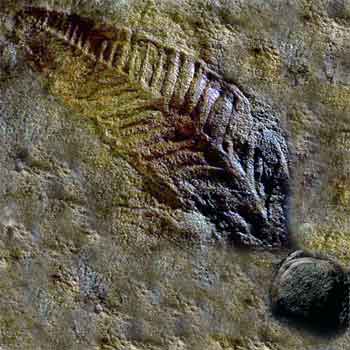 Charniodiscus, that bears resemblance to a feather attached to a ball. Discovered by Jim Gehling, and then classified as a soft coral. Seilacher's view is that its body couldn't have filtered nutrients, because, "A filter must have holes, like a net or a feather, but this organism didn't." Seilacher criticises, these fossils give the appearance of thin, fluid-filled mattresses divided into compartments, which is a body plan unknown in any animal or plant kingdom, "We have nothing like this today." Seilacher has placed the Vendobionts in a distinct, but extinct kingdom of their own.
Charniodiscus, that bears resemblance to a feather attached to a ball. Discovered by Jim Gehling, and then classified as a soft coral. Seilacher's view is that its body couldn't have filtered nutrients, because, "A filter must have holes, like a net or a feather, but this organism didn't." Seilacher criticises, these fossils give the appearance of thin, fluid-filled mattresses divided into compartments, which is a body plan unknown in any animal or plant kingdom, "We have nothing like this today." Seilacher has placed the Vendobionts in a distinct, but extinct kingdom of their own.
This fossilized imprint of a frond-shaped organism and its circular footing, that dwelled in the ocean waters around 550 millions years ago. Paleontologists believe fossils such as this one, are the first evidence of large, multicellular life.
Paraphrased from National Geographic, The Rise of Life on Earth, Life grows up April 1998
Richard Monastersky, with image modifications on the original of O. Louis Mazzatenta
Some of the Ediacaran fossils, reach as much as three feet across and lived at the close of the Precambrian, between 600 million and 540 million years ago. The appearance of the life represented by these fossils, ended three billion years of domination by bacteria, and set the stage for the rise of larger animals.
The Ediacaran fossils are variegated in shape and form, from spoked wheels, anchors, ribbons and fronds. The first were discovered during the 1800's in England, but went primarily un-noticed until Australian geologists turned up a discovery in the 1940's. At the time of the discovery, Scientists classified them as jellyfish, worms and soft corals. However, further discoveries overturned those presumptions. "A short time ago we thought we knew how these organisms related to modern animals. Now we're not so sure." says Guy Narbonne, of Queen's University, Kingston, Ontario.
Fossils of the Ediacaran are the key for insight into the origins of animal life. Some fossils of the Ediacaran were the eldest representatives of our own kingdom, while others existed for a brief time, and disappeared. Some were bizarre, flat-bodied organisms, and paleontologists simply aren't certain how to classify them. All the same, these creatures dwelled long before predators began roaming the oceans, before defensive mechanisms such as shells and hard skeletons evolved.
Observing one Dickinsonia fossil which resembles a footprint like the one Astronauts left on the moon, and the size of a welcome mat, Guy Narbonne remarks, "When this was alive, it would have lain like a flat sheet on the sea bottom. It might have absorbed nutrients directly from the water. Algae may have lived within it, helping harness the sun's energy. It couldn't swim. It probably couldn't even crawl. It was a strange and beautiful creature that apparently disappeared 540 million years ago without leaving any modern relatives."
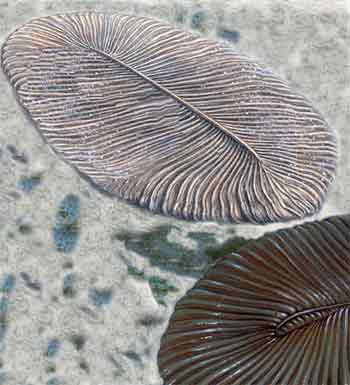 Dikinsonia grew to a length of as much as two feet (60 cm), which made it one of the larger complex organisms of the Vendian. It's body is segmented with midline symmetry dividing it's body. Its body may have been denser than modern jellyfish or worms. [Atlas of Prehistoric World, Discovery Books
Dikinsonia grew to a length of as much as two feet (60 cm), which made it one of the larger complex organisms of the Vendian. It's body is segmented with midline symmetry dividing it's body. Its body may have been denser than modern jellyfish or worms. [Atlas of Prehistoric World, Discovery Books
Reconstruction of Dickinsonia, based on images from Atlas of the Prehistoric World, Discovery Channel Books and Kingfisher Illustrated Dinosaur Encyclopedia
Long before species known from the Vendian came on the scene around 600 million years ago, evolution worked primarily with microorganisms on the microscopic scale. These microbes appeared between 4 billion and 3.5 billion years ago. Algae arrived more than 1.5 billions years ago, and was followed by single-cell organisms, ancestors of complex organisms. Due to lack of oxygen in the ocean and atmosphere, life was constrained to smaller and simple organisms.
Earth's shape and form, itself has evolved. One billion years ago, all the continents were connected in a single enormous land mass called Rodinia, except for the green pond scum, it was a desolate sandy, rocky landscape which contained no trees, grass, or even moss.
Around 750 millions years ago, Rodinia began dividing into smaller continental masses. Over the following tens of millions of years, some of the masses collided again, which formed Himalya-sized mountain ranges, redirecting currents in the ocean and altering Earth's climate. Convulsions such as these caused as many as five ice ages, and the earth was left covered in ice.
This break-up of the Rodinian land mass had profound effects on the evolution of life, infusing the ocean with oxygen, which allowed organisms to develop into larger life forms. Says paleontologist Richard Jenkins of the University of Adelaide, "As oxygen levels rose, there was the potential for the proliferation of animal life."
Oxygenating Earth's Atmosphere
All bacteria which use photosynthesis, produce oxygen, a bi-product of using carbon dioxide, water and sunlight to replicate their cells. This build-up of oxygen in the atmosphere did not become significant enough to support life, until around 2.5 billion years ago, as bacteria spread in greater numbers. Prior to that time, Earth's atmosphere comprised mainly of carbon dioxide and nitrogen gas.
Source: Atlas of the Prehistoric World, Discovery Channel
Many of the fossils which came from later eras are easier to distinguish than Ediacaran fossils, due to their mineralized shells and bones, and even color, which differentiates many of them from the surrounding rock. However, Ediacaran species contained no hard parts, and were not preserved as easily, all that remains are impressions that were made in sand on the ocean floor, like footprints, which was soon followed by physical decay of their body.
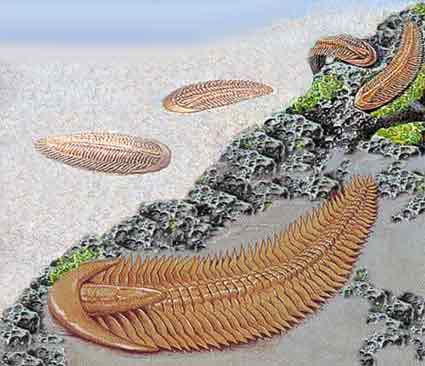 Reconstruction of Spriggina, based on images from Atlas of the Prehistoric World, Discovery Channel Books; National Geographic, The Rise of Life on Earth, Life grows up, and Kingfisher Illustrated Dinosaur Encyclopedia
Reconstruction of Spriggina, based on images from Atlas of the Prehistoric World, Discovery Channel Books; National Geographic, The Rise of Life on Earth, Life grows up, and Kingfisher Illustrated Dinosaur Encyclopedia
One of the Ediacaran fossils was dubbed Spriggina, in honor of Sprigg, curved like a comma with a boomerang-shaped head and its body divided into dozens of parallel segments. Based on its shape, Australian paleontologists classified Spriggina as a relative of the modern earthworm, determining that it was likely a form of segmented worm.
The first scientist to study Ediacaran fossils was Martin Glaessner, a renown Australian paleontologist. In the 1950's, Glaessner classified them among representatives of modern phyla and categories of animals based on comparative anatomy. He proposed the circular impressions were made by jellyfish and categorized the oval fossils similar to trilobites as forerunner to insect and crustacean species. Both Spriggina and Dickinsonia with their characteristic segmented body, have been interpreted as belonging among worms.
The discovery of the Ediacaran fossils bridged the gap on the problem that had troubled scientists since the time of Charles Darwin. In the time of Darwin, Precambrian rocks were still regarded barren, Cambrian rocks however contained an abundance of fossil evidence. For Darwin, the fundamental problem was if natural selection occurred gradually, the lack of Precambrian life undermined his theory.
The Cambrian Explosion brought about a burst of animal life, around 540 million years ago. Within a brief period of geological time, the oceans became filled with representatives of almost all living phyla. Ancestors of mollusks, crustaceans, starfish and snails, even animals such as Pikaia, which hinted at the first species with a backbone.
The discovery of Ediacaran fossils by Sprigg, were regarded as the solution to Darwin's dilemma, at long last having the evidence to fill the gap between modern animals, the groups that blossomed during the Cambrian, and the simpler ancestors which preceded them. In 1983, German paleontologist Dolf Seilacher challenged the theory that organisms of the Ediacaran gave rise to later species. Seilacher's view was that the body plans were too simple and strange to have any relation with animals. Even the sponge, the most basic creature, is divided into parts with a mouth like opening, leading to a digestive compartment, and the more complicated species have specialized organs and appendages, however, the Ediacaran fossils, show no such features. "We don't see any indication of organs. We see no legs, no mouths, no anuses, no digestive tracts, nothing to suggest they were animals. We have to stop shoehorning them into categories of modern animals." Seilacher described them as immobile, jelly-filled organisms and classified them as Vendobionts. The fossils show no characteristics indicating the ability to eat or digest food, but may have absorbed sunlight or chemical nutrients direct from the ocean water.
Since Seilacher's criticism, researchers have discovered further Precambrian sites in Russia, Namibia, Newfoundland, and Australia, including more fossil specimen which turned up in Nevada.
Studies of the fossils, have brought about more agreement between scientists. Two categories have been developed. "Some were certainly animals," says Jim Gehling, while "Others were truly bizarre."
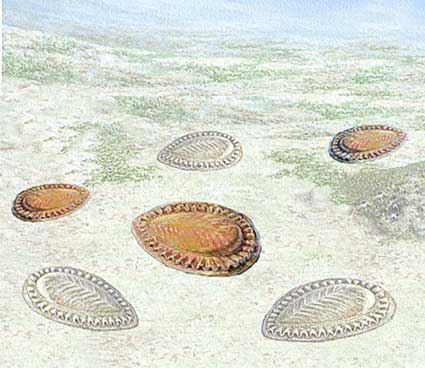
Reconstruction of Kimberella, based on images from National Geographic, The Rise of Life on Earth, Life grows up, and Kingfisher Illustrated Dinosaur Encyclopedia
One Ediacaran fossil named Kimberella, shares striking similarities with mollusks, and is believed to be an early predecessor of snails and clams. Kimberella left fossil evidence in sandstone, identifiable by the short parallel scratches which resemble rows of quotation marks, and provides further evidence that complex, mobile animals emerged before the Cambrian explosion.
Another fossil provided by Gehling, was of a strange organism called Phyllozoon, a foot-long creature divided in zigzag segments. "Phyllozoon is the archetypal Vendobiont. We have no modern equivalents. I think Phyllozoon was a quilted organism that lived by colonizing bacteria and algae in its chambered body, which might account for its bizarre shape. It may have needed a large surface area to absorb sunlight or chemicals from the water." Paleontologists are unsure where to place the Vendobionts. Gehling suggested that they may have even been some kind of unusual algae. All scientists agree on one thing, the Vendobionts left no heirs. Some scientists believe that a change in the chemistry of ocean water, lead to the Cambrian explosion, while other scientists believe it was set into motion by genetic factors.
The late Precambrian, was a time in the history of the Earth when large, immobile and defenseless creatures flourished because nothing was around to eat them.
Gehling on the Precambrian, "We're looking at evolution sitting on a knife-edge. It could have gone in many different ways. This was a time of experimentation."
Text paraphrased from portions of National Geographic, The Rise of Life on Earth, Life grows up April 1998
Richard Monastersky, with image modifications on the original of O. Louis Mazzatenta
THE VENDIAN PERIOD
Fossil evidence implies multi-celled organisms began in the oceans during Precambrian times, once believed absent of complex life.
The Vendian closed around 545 million years ago. This was a time in Earth's history of shifting continents and changes in the atmosphere and chemical make-up of the oceans. Geologists have discovered that during Vendian times, the earliest continental masses were centralized in the Southern Hemisphere, with Northwestern Africa located in the region of the South Pole. In the late Vendian, the continental masses formed a supercontinent known as Pannotia.
In the decades following Darwin, scientists regarded the Vendian as a barren wasteland of rock and desolate of life. This early landscape was indeed an unpromising scene for the propagation of life, barren, even with its rivers, lakes and the extensive desolate rock and sediment. However, the ocean with its ability to filter out dangerous rays to delicate single-celled organisms and keep them moist, was another matter. Both direct and indirect fossil evidence, and the diverse lifeforms that followed in the Cambrian period, implies that life began in the Vendian ocean. Research has suggested that groups of complex organisms, apart from higher plant species, in all likelihood, must have evolved during the Vendian period. Unfortunately, due to the soft-bodied structures, the majority left no fossil evidence. The Ediacarans, which appear to be extinct forms of early jellyfish or worms, are the exception, being the first, larger organisms which left distinguishable fossil impressions in ocean sediment.
Precambrian Oil
Geologists have discovered traces of oil and gas in Australia and South Africa which date around 2 billion years old. Since geologists know oil and gas are a natural bi-product of decay in tiny marine lifeforms, their presence implies the earth was well-populated with active microbes, more than previously assumed.
The most primitive life forms of bacteria date at least to 3.8 billion years. Microbes use photosynthesis as a means for their food supply, as a chemical bi-product of using light energy, they produce oxygen. The oxygen was taken up by dissolved iron minerals, which formed sediment known as "banded iron formations". This process continued for nearly a billion years before oxygen made any significant accumulation in the atmosphere. In the Vendian period, oxygen rose from .2% to 17% of Earth's atmosphere, close to the present-day 21%.
|
THE VENDIAN GLOBE A globe of the Earth (below) reflecting location of land masses during the late Precambrian, as Geologists have came to understand from their studies of geological strata. It was a world, quite unfamiliar to us. During the Vendian, land covered much of the Pacific Ocean realm. Ancient seas covered the hemisphere where Europe, Asia and Africa now exist. Only two primary continents dominate, the great land masses of Northern Gondwana, what now is India, Antartica, and Australia while Southern Gondwana went on to form what is now Africa, North and South America and parts of Asia. Some tropical regions of the Earth today, were setting in the South Pole covered with glacial ice.
|
Paraphrased and image based on Atlas of the Prehistoric World, 1999, Discovery Channel Books by Douglas Palmer
REFERENCES  The Complete National Geographic, 111 Years; 1888-2000
The Complete National Geographic, 111 Years; 1888-2000
 Kingfisher Illustrated Dinosaur Encyclopedia, Kingfisher Publishers, David Burnie
Kingfisher Illustrated Dinosaur Encyclopedia, Kingfisher Publishers, David Burnie
 Atlas of the Prehistoric World, by Discovery Channel Books, Douglas Palmer
Atlas of the Prehistoric World, by Discovery Channel Books, Douglas Palmer
FURTHER SUGGESTED READING
Adrienne Mayor's books
1) The First Fossil Hunters (Princeton 2000) explains how ancient Greek and Roman discoveries of mysterious petrifed bones of extinct dinosaurs and mastodons led to myths about griffins, giants, and monsters. Watch for "Ancient Monster Hunters" on the History Channel.
2) Fossil Legends of the First Americans (Princeton 2005) gathers exciting Native American discoveries and myths about fossils, from tiny shells to enormous dinosaur bones, with stories from more than 45 different tribes, beginning with the Aztecs & Incas.
Stephen Meyer's article, "Are Dinosaurs Mentioned in the Bible?"



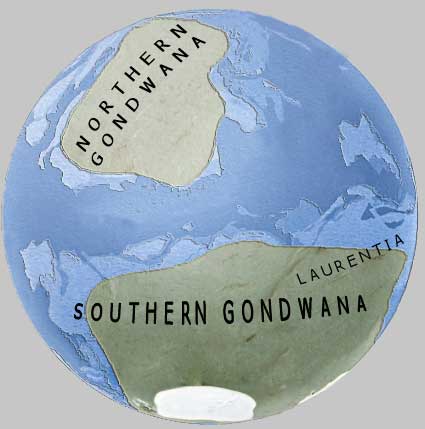

No comments:
Post a Comment